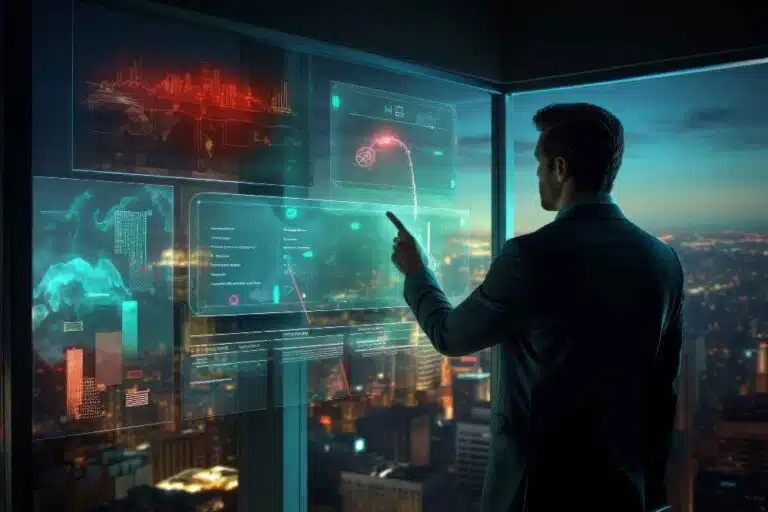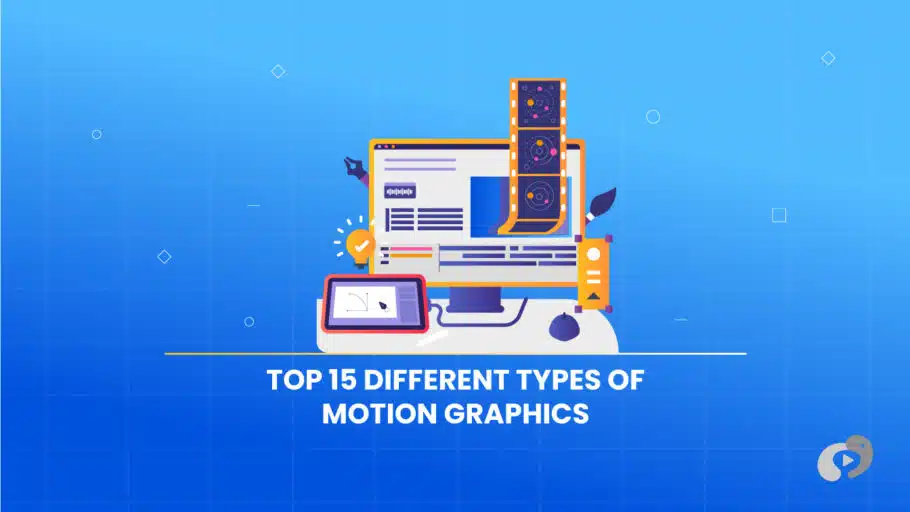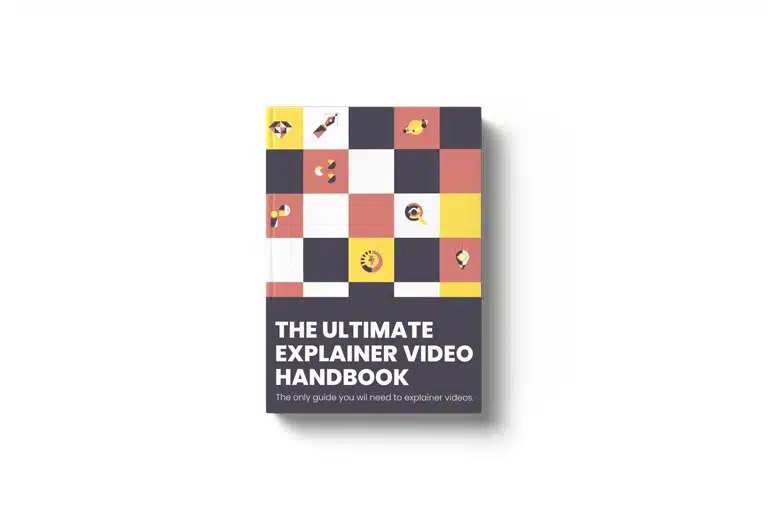Last Updated on September 18, 2024
Article Contents
15 Types of Motion Graphics [Guide for 2024]
Motion graphics have become a cornerstone of visual storytelling in the digital age. From explainer videos to social media posts, motion graphics allow creators to convey complex messages in a visually engaging way. With so many different styles and applications, understanding the different types of motion graphics can help you choose the right approach for your next project. This guide explores 15 types of motion graphics, highlighting their features and uses to help you make an informed decision.
What Are Motion Graphics?
Motion graphics are animated visual elements that bring still images, text, and shapes to life using movement. Unlike full-blown animation or character-driven stories, motion graphics focus more on abstract designs, text, icons, and simple shapes. These animations add depth and visual interest to presentations, advertisements, and videos, making them more interactive and engaging.
Motion graphics can be used for a variety of purposes, such as explaining a concept, visualizing data, enhancing a brand’s presence, or adding visual effects to film and TV. While traditional animation focuses on telling stories through character actions and scenes, motion graphics are typically used to explain, clarify, or emphasize key points in an appealing and straightforward manner.
How Many Types of Motion Graphics Are There?
Motion graphics is an umbrella term that covers a range of animation styles. While the possibilities are virtually endless, we can break them down into 15 core types of motion graphics based on their distinct uses and techniques.
1. Explainer Motion Graphics
Explainer motion graphics are designed to help audiences quickly understand complex ideas. By using clear visuals, icons, and text alongside narration or sound, explainer videos break down complicated concepts into easily digestible parts.
Explainer videos are ideal for product demonstrations, how-to guides, and corporate training. Their simple and straightforward nature makes them perfect for conveying key information in a short period. Whether introducing a new product or explaining company policies, explainer motion graphics simplify the process for viewers.
2. Infographic Motion Graphics
Infographic motion graphics bring static data to life. Instead of presenting numbers, charts, or graphs as still images, motion graphics can animate these elements, making data more engaging and easier to understand. By visualizing data trends and comparisons, infographic animations can turn boring statistics into an eye-catching and interactive experience.
Businesses, educators, and researchers use infographic motion graphics to present reports, explain data trends, or showcase results. They make large volumes of data more appealing and help audiences grasp key points more effectively.
3. Logo Animations
Logo animations take a brand’s static logo and breathe life into it through movement. Whether through subtle fades, rotations, or intricate 3D effects, animated logos help brands stand out and leave a lasting impression.
A well-crafted logo animation can add professionalism to a brand and is often used in video intros, social media posts, or at the end of marketing content. The movement catches the viewer’s eye, reinforcing brand recognition in a memorable way.
4. Typography Animation (Kinetic Typography)
Kinetic typography is the art of animating text to convey emotion or emphasize a message. By manipulating fonts, text size, and movement, kinetic typography can bring words to life and make them a central part of the story.
Used in movie titles, commercials, and music videos, kinetic typography emphasizes key points or adds a dynamic touch to an otherwise static presentation. It can be playful, serious, or energetic depending on how the text is animated, making it a versatile tool in motion graphics.
5. Whiteboard Animation
Whiteboard animation mimics the effect of a hand drawing on a whiteboard, illustrating concepts as they are discussed. This simple and clear style is highly effective for explaining processes, instructions, or educational content. As viewers watch the drawing come to life, they can better follow the narrative, making the content easier to understand.
Whiteboard animations are often used in tutorials, explainer videos, and corporate training materials. They are an excellent choice for content that needs to educate or inform while keeping viewers engaged with the visual storytelling.
6. UI/UX Animations
User Interface (UI) and User Experience (UX) animations are vital for product demonstrations, app walkthroughs, and website tutorials. These motion graphics show how a user navigates through an app or interacts with a website’s interface.
By demonstrating transitions, button clicks, and menu navigation, UI/UX animations give potential users a clear idea of how a product works, enhancing user understanding and engagement. This type of motion graphic is particularly useful in tech, where explaining functionality is crucial to user adoption.
7. 3D Motion Graphics
3D motion graphics add an extra layer of depth and realism by creating three-dimensional objects that can move and interact within a virtual space. These graphics are visually striking and offer more detail than 2D animations, making them ideal for product demonstrations, architectural visualizations, or virtual tours.
While 3D motion graphics require more advanced software and technical skill, the results can be highly impactful, creating immersive and visually compelling content that stands out from standard animations.
8. Character Animation in Motion Graphics
Character animation within motion graphics is used to bring animated characters to life alongside graphical elements. This type of animation is often found in explainer videos where characters interact with infographics or narrate the story.
Character animation helps humanize the content, making it more relatable for audiences. By adding facial expressions, body language, and movement to characters, brands and educators can make their message more engaging and memorable.
9. Title Sequences and Movie Trailers
Motion graphics are heavily used in title sequences for movies and TV shows, setting the tone and style before the content begins. These sequences often combine text, colors, and motion to build excitement or introduce a theme.
In movie trailers, motion graphics can be used to highlight key moments, show off special effects, or reveal important information in an exciting and dynamic way. Title sequences and trailers rely on motion graphics to capture attention and create anticipation for the content that follows.
10. Broadcast Graphics
Broadcast graphics are widely used in television news, sports broadcasts, and live events to present information in real-time. These animations include lower thirds (the text banners at the bottom of the screen), transitions, and graphics that highlight scores, stats, or breaking news.
The quick, dynamic nature of broadcast graphics keeps viewers informed and engaged without interrupting the flow of the program. Their design is often minimalist but visually sharp, helping convey information efficiently.
11. Social Media Motion Graphics
Social media motion graphics are short, engaging animations designed to quickly capture attention on platforms like Instagram, Facebook, and YouTube. These animations are optimized for mobile viewing and are usually no more than a few seconds long.
Social media motion graphics often include animated text, logos, and graphics that highlight products, promotions, or brand messages. Their purpose is to be eye-catching and shareable, increasing engagement with the content.
12. Data Visualization
Data visualization motion graphics transform raw data into dynamic visuals that are easier to interpret and understand. This type of animation is commonly used in presentations, business reports, and educational videos to showcase trends, patterns, or results in a visually appealing way.
Through the use of animated graphs, pie charts, and bar charts, data visualization motion graphics help viewers process information more efficiently, making complex data sets more accessible.
13. HUD (Heads-Up Display) Graphics
HUD (Heads-Up Display) graphics are often seen in sci-fi films and tech-related content, simulating futuristic digital interfaces. These animations are designed to mimic real-time data display, often giving viewers the impression they are looking through the eyes of a character or machine.

HUD graphics add a high-tech, cutting-edge feel to videos and are used in films, video games, and technology demos to simulate the look of advanced digital displays.
14. Isometric Animation
Isometric animation creates a 3D-like effect using 2D objects. By tilting and rotating flat objects, designers can give the illusion of depth without the need for complex 3D modeling. This type of animation is commonly used in architectural visualizations, video games, and product demonstrations.
Isometric animations offer a unique way of visualizing space and depth, making them ideal for explainer videos that need to showcase buildings, spaces, or designs from different angles.
15. Iconography Animation
Iconography animation involves animating icons or small visual elements to add motion to websites, apps, or presentations. These animations are subtle but effective in guiding users’ attention, enhancing the usability of a digital interface, or adding flair to a video.
Animated icons are often used in product tutorials or apps to demonstrate functionality, making them more intuitive and user-friendly.
Importance of Choosing the Right Type of Motion Graphics
Selecting the right type of motion graphic can make or break your project. The style of animation should match the tone, purpose, and audience of your content. For instance, while infographic motion graphics may work well for data-heavy presentations, character animations may be more effective for storytelling or customer engagement.
Before choosing a motion graphic style, consider the following factors:
- Audience: Tailor the animation style to your target demographic. Younger audiences may enjoy playful, character-based animations, while business professionals might prefer clean, data-driven designs.
- Message: Think about the core message of your video. If you need to explain a complex topic, explainer videos or whiteboard animations may be the best fit. If your goal is to increase brand awareness, a logo animation or social media motion graphic could be more effective.
- Platform: Where will your content be viewed? Social media content should be short and attention-grabbing, while presentations or training materials can use more detailed animations to ensure clarity.
By choosing the right type of motion graphics for your project, you can ensure that your message is communicated clearly and effectively, leaving a lasting impression on your audience.
Conclusion
Motion graphics are a versatile tool for visual storytelling, offering endless possibilities for enhancing videos, presentations, and digital content. By understanding the different types of motion graphics and their applications, you can select the right approach for your project, ensuring that your content is both engaging and effective. From explainer videos to social media animations, motion graphics offer a dynamic way to communicate ideas and make your content stand out in 2024 and beyond.

